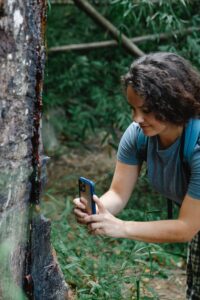
80% of the carbon footprint of our electronic devices is produced in the production phase, during the extraction of raw materials, transportation, manufacturing of the different parts, assembly, and distribution to points of sale.
In addition, the manufacture of each device requires raw materials, many of which are extracted through mining. Mining has strong environmental impacts, such as loss of biodiversity, soil contamination, deforestation; and also social impacts, such as the displacement of communities living in the territories where these resources are exploited, illegal financing of weapons by armed groups in conflict territories, precarious working conditions in the mines, insecurity and exposure to toxins, and child labor in many cases. In the manufacturing phase, we also found strong violations of human and labor rights, especially among women, who make up the majority of assembly line workers in many factories. Among these violations, we find excessive working hours, precarious wages, repression of unionization, exposure to toxins, among others.
When our devices break down, or we replace them with new ones, the impacts continue: high pollution caused by electronic waste landfills, waste of resources, export of waste to countries without an adequate recycling infrastructure…
For all these reasons, one of the most effective ways for consumers to reduce this carbon footprint, and the impacts associated with the production and consumption of electronic devices, is to try to extend the useful life of the device as much as possible.
On the other hand, during the time we use these devices, we can become very vulnerable in terms of our data privacy if we are not careful about how we access our information on the Internet.
Summer is a time of the year when we can spend more time outdoors doing outdoor activities. Temperatures are higher, and we often spend time cooling off by the water. We also have more free time to connect to the Internet during vacation days, and we may spend a few days visiting another city or country. Summer, therefore, is a time when our data, such as our phones and tablets, are more exposed to different types of risks. From the Just Electronics campaign we share some practical tips to protect our devices and our data!
– Beware of the heat! Most devices are designed to operate between 0 °C and 35 °C, so always leave your device in the shade, and don’t leave it inside the car on very hot days, as heat can damage it! Avoid using it in very hot weather, leaving it switched off, or leaving it on a surface heated by the sun. If it has warmed up, let it cool down in the shade without the casing, and do not put cold air or put it in the fridge… the cold can also damage it.
– Be careful with sand… just as dust is a great enemy of our devices, so is sand! try to use it with clean hands, and protect it from wind gusts.
– Watch out for water: keep your device away from water or use a protective case.
– Turn it off: it is advisable to turn off your device at least once a week, even for a few seconds, and not to keep it always on. This way you will also be able to disconnect more from the Internet and applications, and connect with yourself, the people around you and nature!
– Take care of the battery: do not to let the mobile phone reach too low battery levels, nor overload the battery. The advisable with the current type of batteries is to charge them between 30% and 80%. If you turn off the functionalities that you do not use in every moment (*Bluetooth, Wifi, GPS. etc.) you will avoid the overheating, you will save data, and battery too! You can also adjust the screen brightness if you want to save battery, your eyes will thank you.
– Now you have time to make room! it is better not to fill too much memory on your device, as it can worsen the performance… Delete the applications you do not use, and if you can, leave 25% of memory free- Keep your eyes open at all times: in summer, especially in cities, theft from tourists increases. Don’t carry your devices in accessible pockets, or on the table at the bar…- Make a backup of everything important to save your data in case your device is lost or stolen!- Familiarize yourself with pager applications that protect your device: many brands incorporate applications that can be activated to track your phone in case of theft or loss, do a data wipe, or block the shutdown option… If not, you can also download them. If your device is lost or stolen, you will have to act very fast, so you better know how to use them!
– Insure your device, but not just any way! If you already have a home insurance, check if it covers theft. From SETEM we recommend that you take out all your insurance with insurers that work with ethical and sustainability criteria. Look for them!
– Use an old cell phone: If you want to disconnect and protect yourself from theft, you can always rescue an old, simpler cell phone that still works. If you don’t plan to use it, take it to your SETEM collection point during business hours! We use them for repair workshops in schools, we give them to different initiatives, or we make sure they get to job placement companies that are dedicated to the management of electronic waste and that do their utmost to get them repaired!
– Caution with the use of open wifi networks: Open networks can be a way to save data, but they can also be insecure, as they are very easily accessible to third parties.
– Share these tips with friends and family!

